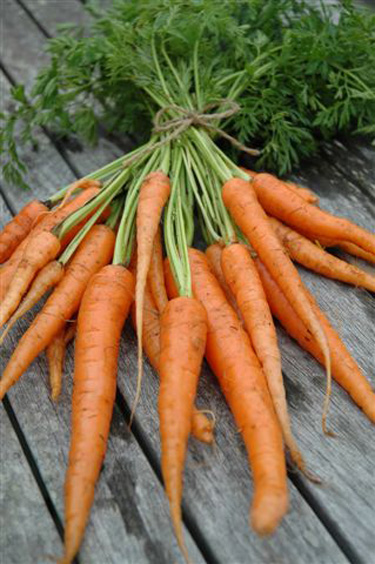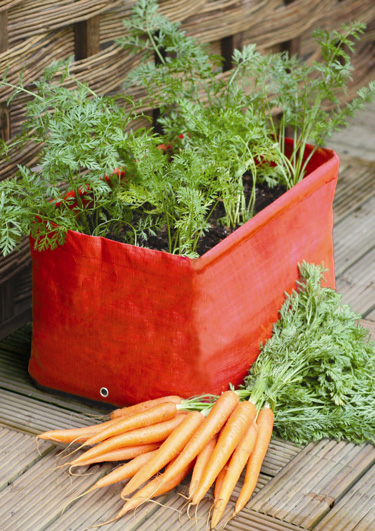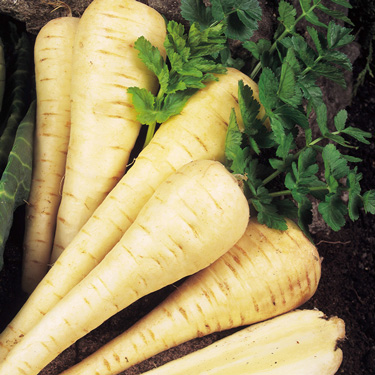Grow root vegetables
Once you’ve sampled the earthy sweetness of carrots and parsnips from your own garden, the shop bought ones may never taste the same.
Hearty root vegetables can be grown for most of the year. Even when winter cold slows their growth they survive in the soil until you need them – an outdoor refrigerator that keeps them crisp and nutrient rich. Because the cold converts starch into sugars, they actually get sweeter when temperatures plummet. Sow some seed now for winter harvest!
The basics
Seed
While it’s possible to transplant seedlings, the best way is to grow root vegetables is from seed.
Soil
Whether you dig your own, or buy bags of growing mix, soil is key. It should drain well and have a loose, even texture. You may like the quirky look of deformed carrots (they still taste good!), but if you want neat tapered specimens that are easy to peel, remove lumps of compacted soil and stones that send impressionable young taproots growing in all directions.
Nitrogen – not too much!
Excessive fertiliser, especially nitrogen, will also lead to warped carrots. The ideal soil for root veges is where there previously grew a well-fertilised crop of leafy greens. Otherwise, apply a side dressing of balanced general garden fertiliser or liquid feed once carrots are growing.
Thinning
Once the seedlings are 3-5cm tall it’s time to sacrifice a few seedlings to make room for others to grow. Leave about 2-3cm between each seedling. As the plants grow, thin them some more and eat the thinnings.
Water
Water to keep the soil moist, especially throughout the hotter months.
Root veges from seed
- In a sunny location, make a bed of fine crumbly soil, at least 30cm deep, or fill a container with planting mix. Water gently with a watering can.
- Gently tap the seeds out of the packet as evenly as possible over the soil surface.
- Sprinkle over a thin (3mm) layer of loose soil or planting mix.
- In the absence of rain, use a soft spray hose or watering can to keep the soil moist without flooding. Carrot seedlings germinate within two to three weeks.
Carrot tricks
- For a continuous supply sow carrots every 3-4 weeks. A year round supply is easy in frost-free climates! In cold climates, sow your last batch of seed 2-3 months before heavy frost. Carrots will survive light frosts.
- Sow radish and carrot seed mixed together. The radishes grow much faster and are ready before the carrots.
- Mix carrot seeds with used coffee grounds before sowing. This will help you space the seeds and also repels pests.
- A fine layer of organic mulch, such as pea straw helps prevent a dry surface crust, which is a barrier for germination.
- In summer, carrot rust flies lay eggs in the soil and their larvae munch holes in our carrots. Discourage them by planting carrots in a different place each year. Choose quick growing varieties, sow in early spring and eat them small, before the worst damage is done. When thinning, push the soil back to prevent the tops from going green and help keep carrot rust fly out.
Parsnip tricks
- Parsnip seed is very short-lived, so to avoid disappointment, use fresh seed. Check the date on seed packets.
- Even with fresh seed and perfectly prepared soil, parsnip seed can take a long time to germinate. Try sowing rows of radishes as markers between rows of parsnip. The radishes will be ready to eat when the parsnips are ready for thinning.
- Parsnips are incredibly cold resistant and can be stored in frozen ground, until you eat them. But do harvest before growth starts in spring, or they’ll turn woody and unpalatable. The variety ‘Hollow Crown’ is recommended for late summer sowing.
Carrots in containers
Containers (or raised beds) are great for growing carrots, as you can control the quality of your soil. They will however, need more attention to watering than carrots growing in the open ground. Feed with liquid fertiliser every 2 to 3 weeks.
Varieties
Carrots come in a range of shapes, sizes and colours, with some interesting heritage varieties. For containers and heavier soils quick maturing baby carrots and other shorter varieties are ideal. Ask at your Go Gardening centre which varieties grow best in your area.
For more information about carrot and parsnips varieties, go to www.yates.co.nz and www.kingsseeds.co.nz
In the kitchen
- Roast a medley of carrots, parsnips and beetroot; cut into bite-sized wedges, and coat with olive oil and rosemary.
- Take your favourite carrot cake recipe and substitute grated parsnip for carrot – even sweeter!
- Make mini carrot cakes in muffin pans and serve hot with butterscotch sauce and ice cream.
- Glaze steamed or microwave carrots with butter and maple syrup.
- Or toss baby carrots in butter and freshly chopped French tarragon with a dash of honey and white wine vinegar.
30-Mar-2015

Baby carrots

Carrot planter

Parsnips

